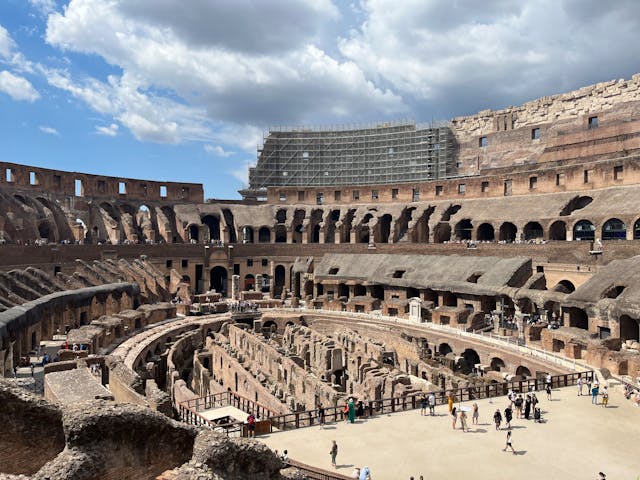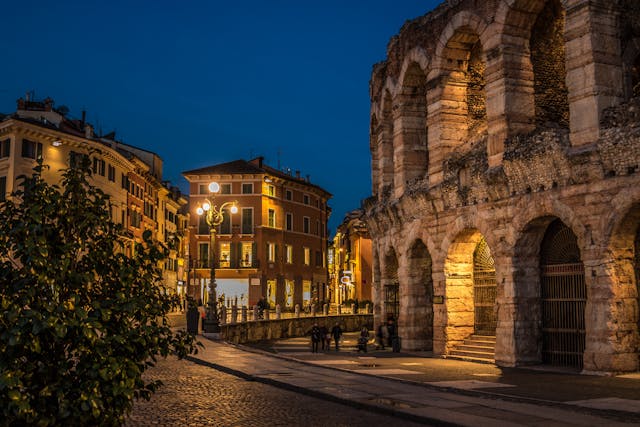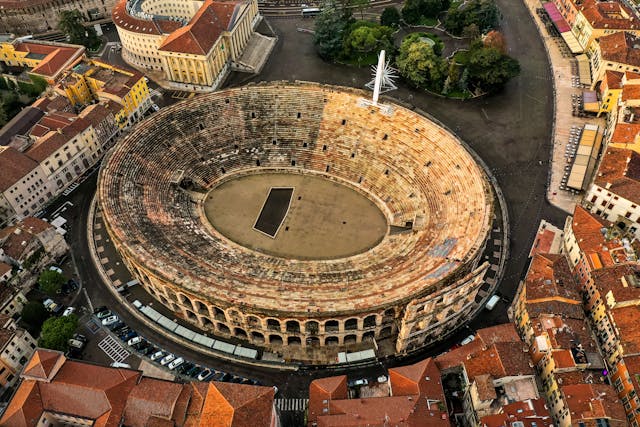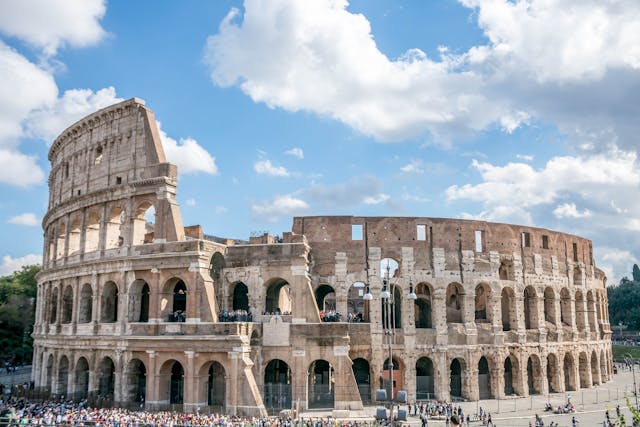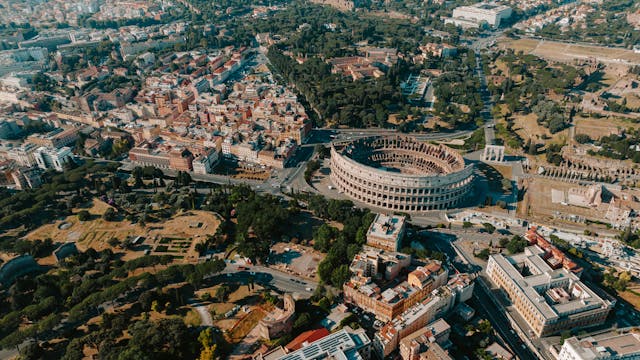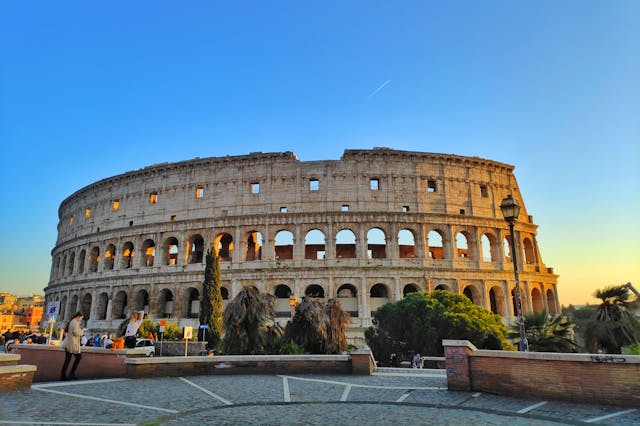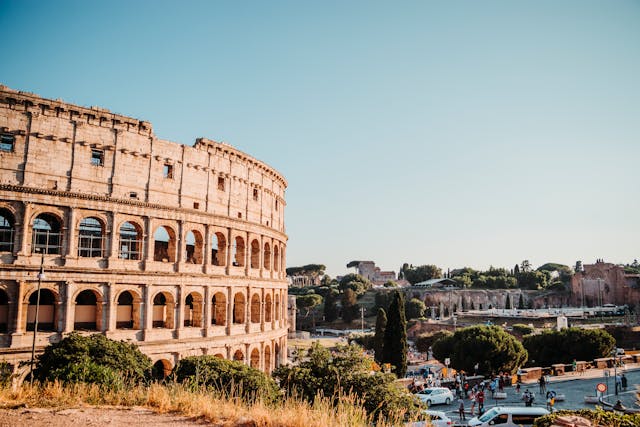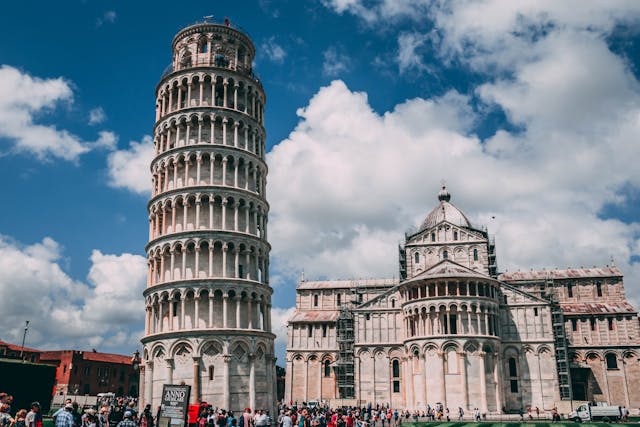The Colosseum is one of the most famous landmarks in the world. It’s a symbol of Ancient Rome and a must-see in Rome. This giant building was used for gladiator fights and other big events. If you plan ahead, your visit will be even better. You’ll know the best time to go, how to get there, and what to expect inside.
Here’s everything you need to know about visiting the Colosseum.
Overview of the Colosseum
The Colosseum was built almost 2,000 years ago. It could hold 50,000 people. It was used for gladiator battles, animal hunts, and big shows.
The Colosseum is a marvel of ancient engineering. Made of stone and concrete, it has survived earthquakes and time. Inside, there are different levels for different events.
A fun fact: The Colosseum once had a large cover to protect people from the sun.
Planning Your Visit
Best Time to Visit
The best time to visit is during the off-season, from November to March. Fewer people visit, but it’s colder.
If you go during the busy season, try mornings or late afternoons. This way, you avoid crowds and get great photos.
Getting There
The Colosseum is easy to get to. You can take the metro (Line B, Colosseo station), a bus, or walk.
There are ramps and elevators for visitors with disabilities. These make it easy for everyone to enjoy the visit.
Tickets and Tours
Ticket Options
There are different ticket types. A basic ticket lets you see the Colosseum. Combo tickets also include the Roman Forum and Palatine Hill.
Guided tours are popular too. Prices vary, but there are discounts for children, students, and EU citizens under 26. Booking online helps you skip the long lines.
Guided Tours vs. Self-Guided Visits
Guided tours are a great way to learn about the Colosseum’s historical significance. Guides share stories about gladiators and ancient events. Many tours also let you skip the lines.
If you prefer to explore on your own, a self-guided visit works too. You can use an audio guide or a guidebook to learn as you go.

This 6-hour private tour covers the top sights in Rome, including the Vatican, Sistine Chapel, Colosseum, and Roman Forum. Visit landmarks like St. Peter's Basilica and the Pantheon, all with an expert guide. Skip the lines and explore the city's most historical sites in one day.

Discover the ancient ruins of the Colosseum and Roman Forum on a 3-hour guided tour. Explore iconic sites like the Arch of Constantine, Temple of Julius Caesar, and the House of the Vestal Virgins. Skip long lines and delve deep into the history of Ancient Rome with a local expert guide.

Skip the lines and step into Ancient Rome with this exclusive guided tour. Using Virtual Reality, you'll experience the Colosseum and Roman Forum as they once were. Led by a knowledgeable guide, this immersive tour offers a unique way to explore Rome's historic wonders.
What to Expect During Your Visit
Key Areas to Explore
When you enter the Colosseum, you’ll want to see the main attractions. The arena floor is where the gladiators fought. It’s a huge open space, and you can almost imagine the battles happening. You’ll also want to visit the underground passages. This is where animals and gladiators waited before the shows. It’s fascinating to see how everything was organized.
Nearby, the Roman Forum and Palatine Hill are also worth visiting. The Roman Forum was the heart of Ancient Rome, full of temples and markets. Palatine Hill is where Roman emperors lived. Both sites are close to the Colosseum and give you more of a feel for ancient Roman life.
Visitor Experience Tips
To avoid large crowds, try visiting early in the morning or later in the afternoon. Most people visit in the middle of the day, so going at quieter times will help you have a more peaceful experience.
For great photos, make sure to stand in front of the Colosseum’s arches. The light early in the morning or late in the day is perfect for pictures. It’s also a good idea to take photos of the surrounding areas, like the Roman Forum or Palatine Hill, for a full experience.
Additional Tips for a Memorable Experience
What to Bring
Before you head to the Colosseum, make sure you bring some important things. A water bottle is essential because it can get hot. You’ll also want some sunscreen to protect your skin. Finally, don’t forget your camera to capture the amazing views and moments.
Dining Options Nearby
After visiting the Colosseum, you’ll be hungry. Luckily, there are lots of good places to eat nearby. For a quick bite, try one of the cafes around the Colosseum. They often have pizza, pasta, and coffee. If you’re looking for a sit-down meal, there are restaurants in the area that offer traditional Roman dishes.
Cultural Significance
Symbolism of the Colosseum
The Colosseum is a powerful symbol of Ancient Rome and its rich history. It represents the might and power of the Roman Empire, where gladiators once fought in front of massive crowds. This iconic structure has stood the test of time and remains a central symbol of Rome's cultural heritage.
In modern media, the Colosseum has been portrayed in movies like Gladiator, bringing the ancient battles back to life on the big screen. Through such portrayals, the Colosseum continues to be a symbol of strength, courage, and survival.
Influence on Architecture
The Colosseum has influenced amphitheater design around the world. Its unique design, featuring multiple levels of arches and columns, set the standard for arenas and stadiums throughout history.
The Colosseum’s impact can be seen in the design of modern sports arenas, where similar structures are used to provide seating and enhance visibility for large crowds. It’s clear that the Colosseum's architecture shaped how we think about large public venues today.
Related: Day Trip to Pisa: A Guide to Making the Most of Your Visit
Safety Tips
Health and Safety Guidelines
When visiting the Colosseum, it’s important to be aware of your surroundings. Large crowds can sometimes make it difficult to keep track of your belongings. Pickpocketing is a concern, so always keep your bags close and be mindful of your personal items. If you’re traveling with kids, keep a close eye on them in crowded areas.
Additionally, make sure to stay hydrated as it can get hot, especially in the summer months. Carry a water bottle and take breaks in shaded areas to avoid heat exhaustion.
Weather Considerations
Rome’s weather can vary, so be prepared for different conditions. In the summer, the sun can be intense. It’s a good idea to wear sunscreen and a hat for sun protection. Drink plenty of water to stay hydrated. During the colder months, make sure to dress warmly, especially if you're visiting in the early mornings or evenings when temperatures can drop.
Also read: Switzerland Itinerary: Top Destinations and Experiences
Photography Tips
Best Spots for Photos
The Colosseum offers countless opportunities for stunning photos. For a classic shot, position yourself in front of the arches to capture the full grandeur of the arena. Inside, the arena floor and underground passages make for fascinating photos. You can also take great pictures from the upper levels, where you’ll get a panoramic view of the Colosseum and the surrounding Roman ruins.
Outside the Colosseum, the surrounding areas like the Roman Forum and Palatine Hill also provide beautiful backdrops for photography, especially if you want to capture the historic landscape of Ancient Rome.
Time of Day for Optimal Lighting
To get the best lighting for your photos, visit the Colosseum either early in the morning or late in the afternoon. The soft golden light during these hours makes for dramatic and stunning photos, especially when the sun hits the Colosseum’s arches. The early morning also offers fewer crowds, which means you can capture the Colosseum without too many people in your shots.
Also read: Europe Travel Tips for Families: Enjoying Your Trip with Kids
Nearby Attractions
Exploring the Surrounding Area
The Colosseum is surrounded by several fascinating historical sites. The Roman Forum is just a short walk away and was once the center of political, religious, and social activity in Ancient Rome. Don’t miss Palatine Hill, which offers breathtaking views of the Colosseum and was home to Roman emperors. Both sites give you a deeper understanding of ancient Roman life.
Another nearby attraction is the Arch of Constantine, located next to the Colosseum. This triumphal arch commemorates Emperor Constantine’s victory at the Battle of Milvian Bridge and is another key piece of Roman history.
Local Dining Recommendations
After exploring the Colosseum and nearby attractions, treat yourself to a meal at one of the local restaurants. Just a short walk away, you can enjoy traditional Roman dishes at Trattoria Al 19 or Ristorante Aroma, which offers a fantastic view of the Colosseum. For a more casual bite, try one of the cafes nearby for a coffee or pizza. These dining spots offer the perfect way to end your Roman adventure.

Premium Colosseum, Palatine Hill & Roman Forum Private Tour - $297.26
Step into the past on a premium tour of ancient Rome, led by an expert archaeologist. Explore the Colosseum, Palatine Hill, and Roman Forum, with stories of gladiators and emperors. Discover the grand ruins of the Imperial Palace and stroll through historic temples and the Senate, walking where Julius Caesar once did. It’s a journey through time you won’t forget!

Imperial Rome Including Colosseum with Roman Forum and Palatine Hill Tour - $69.01
Take a 3-hour guided tour through the iconic sites of Imperial Rome. Visit the Colosseum, Roman Forum, and Palatine Hill, exploring the historical significance of each location. Step back in time and experience the grandeur of these world-famous landmarks that represent the heart of ancient Rome.

Rome Colosseum Ancient Rome Exclusive Private Guided Tour - $222.94
Enjoy an exclusive private 3-hour tour of the Colosseum, Palatine Hill, and Roman Forum. Skip the lines and dive straight into the heart of ancient Rome. With a professional guide, learn about gladiators, emperors, and the grandeur of the ancient world, all while discovering the fascinating ruins and historical sites of this incredible city.
Conclusion
Visiting the Colosseum is an unforgettable experience. You’ll learn about Ancient Rome, see incredible architecture, and get a taste of Roman history. By planning ahead, you can avoid crowds and make the most of your time.
Remember to take it all in and enjoy the cultural experience. The Colosseum is just one part of the many amazing sites in Rome. So, make sure to explore more of the city while you’re there!
Visiting the Colosseum FAQ
What is the best time to visit the Colosseum?
The best time to visit the Colosseum is during the off-season, from November to March. You can also visit early in the morning or late in the afternoon to avoid crowds.
How do I get to the Colosseum?
The Colosseum is easy to reach by metro (Line B, Colosseo station), bus, or walking. For visitors with disabilities, there are ramps and elevators available.
Are guided tours worth it?
Yes, guided tours are a great way to learn about the Colosseum's history and skip the lines. You'll also get expert insights into the gladiators and the ancient events that took place there.
Can I visit the Colosseum without a tour?
Yes, you can visit the Colosseum on your own. You can use an audio guide or a guidebook to learn about the site. However, guided tours provide deeper insights into its history.
What should I bring to the Colosseum?
Make sure to bring a water bottle, sunscreen, and a camera for photos. It can get hot, so these items will help make your visit more comfortable.
This blog post may contain affiliate links. If you click on one and make a purchase, I may earn a small commission at no extra cost to you.

Aria Kim, a versatile Asian American journalist, short story writer, and blogger, captivates audiences with her insightful storytelling, seamlessly blending the worlds of news reporting and creative expression as a dedicated freelancer.
